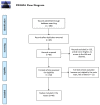Pneumoparotid and Pneumoparotitis: A Literary Review
- PMID: 32498334
- PMCID: PMC7313030
- DOI: 10.3390/ijerph17113936
Pneumoparotid and Pneumoparotitis: A Literary Review
Abstract
Pneumoparotid is a rare condition of parotid swelling. The presence of the air in gland parenchyma is caused by an incompetent Stensen's duct with high pressure may cause the acini's rupture. We reviewed 49 manuscripts, from 1987 to today, that enrolled a total of 54 patients with pneumoparotid. Our review evaluated the following evaluation parameters: gender, age, etiology, clinical presentation, treatment, days of resolution after diagnosis, relapse and complications. The most frequent etiology is self-induction by swelling the cheeks (53.7%). This cause mainly involves children (74%), for conflicts with parents, excuses for not going to school, nervous tics or adults (16%) with psychiatric disorders. Iatrogenic causes are also frequent (16.6%), for dental treatments (55.5%) or use of continuous positive airway pressure (CPAP) (33.4%). Medical therapy is the most practiced (53.7%), in most cases it is combined with behavioral therapy (25.9%) or psychotherapy (25.9%). Surgery is rarely used (9.2%) as a definitive solution through parotidectomy (50%) or ligation of the duct (50%). The most common complication is subcutaneous emphysema (24.1%), sometimes associated with pneumomediastinum (5.5%). Careful treatment and management are necessary to ensure the resolution of the pathology and counteract the onset of complications.
Keywords: Stensen’s duct; head and neck; parotitis; pneumoparotid; pneumoparotitis.
Conflict of interest statement
The authors declare no conflict of interest.
Figures
References
-
- Balasubramanian S., Srinivas S., Aparna K.R. Pneumoparotitis with subcutaneous emphysema. Indian Pediatr. 2008;45:58–60. - PubMed
Publication types
MeSH terms
LinkOut - more resources
Full Text Sources
Medical



